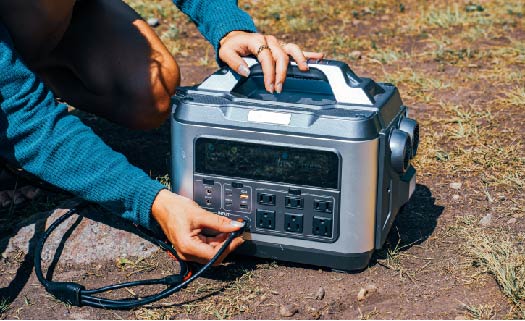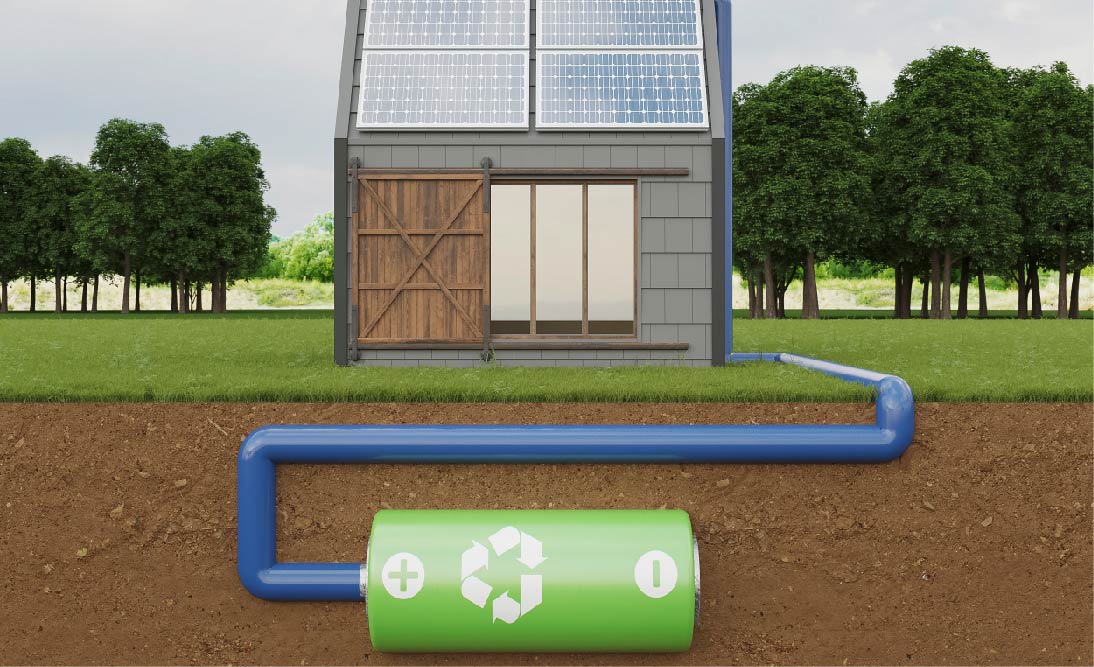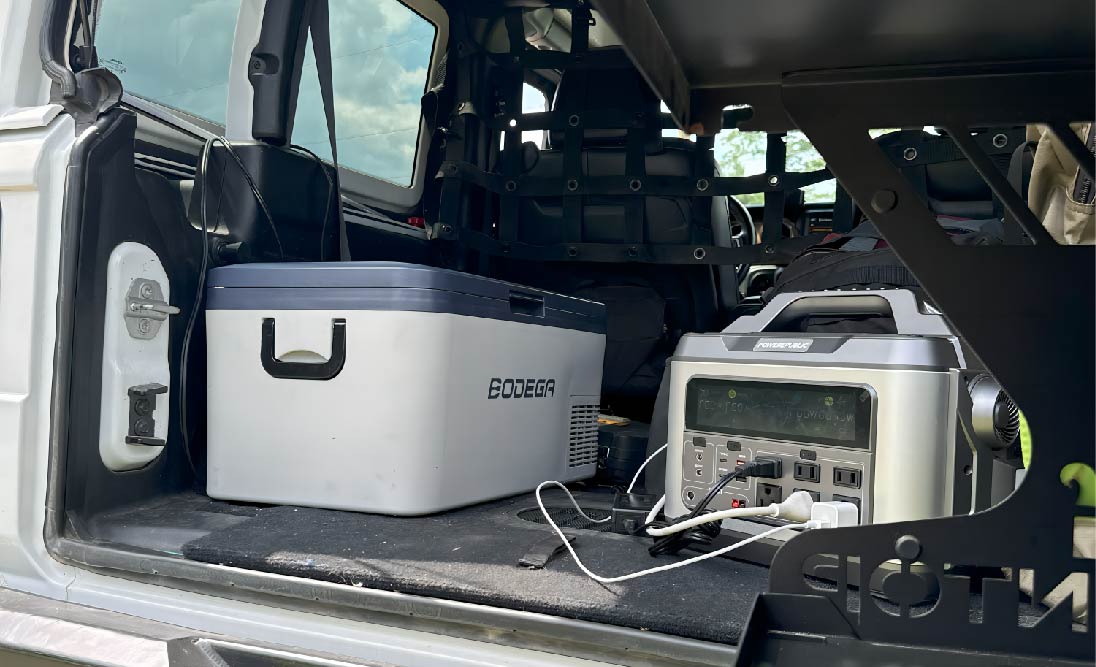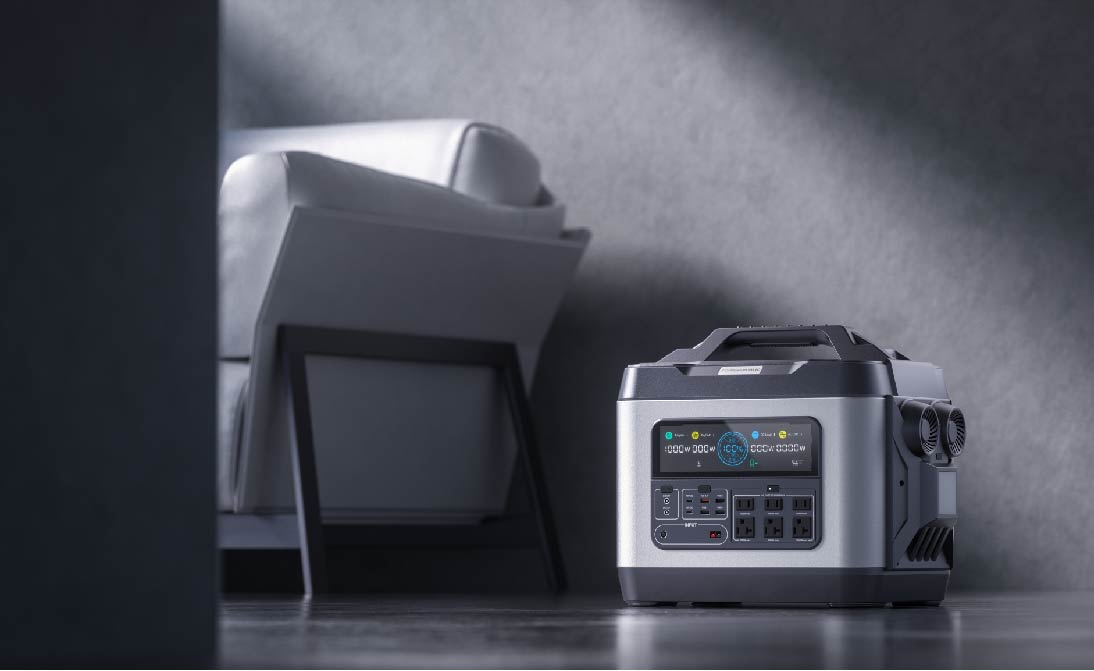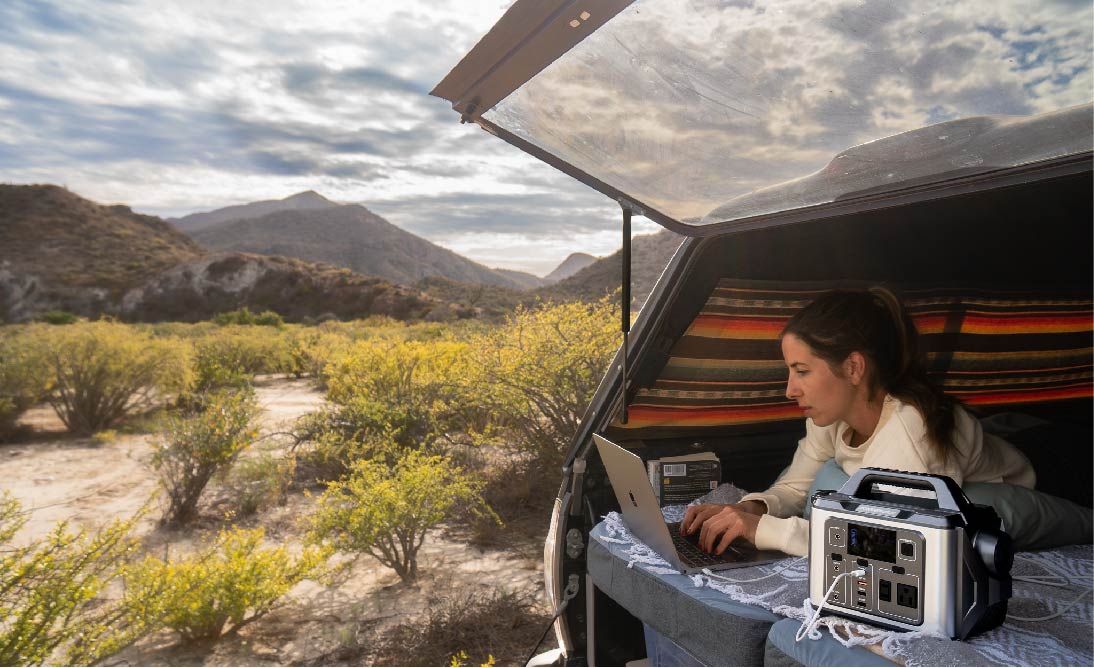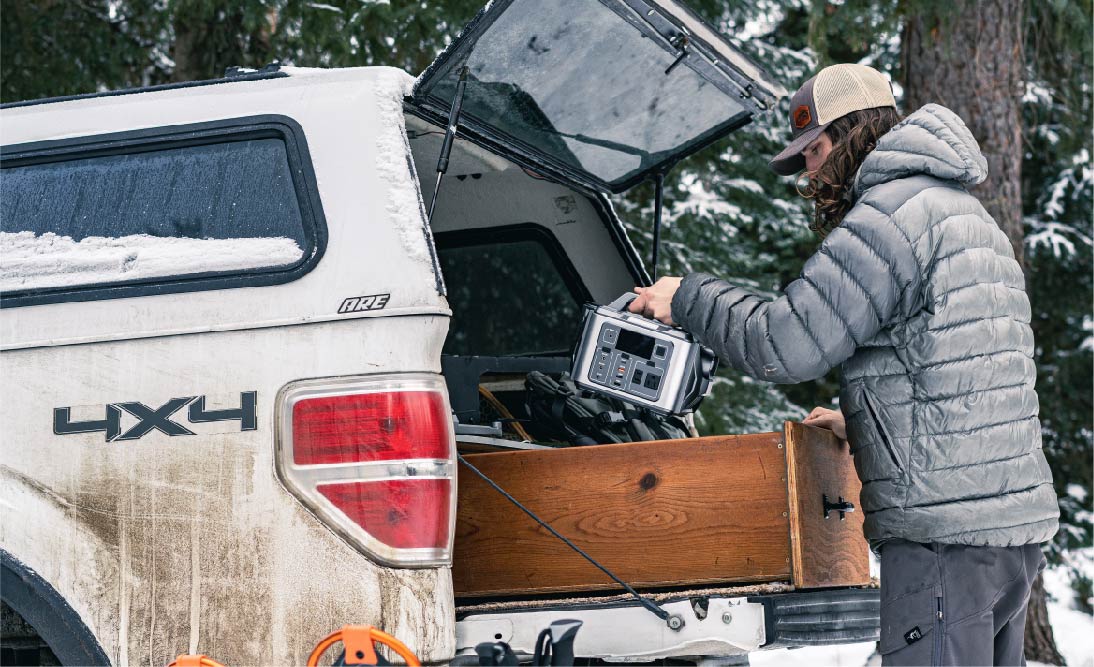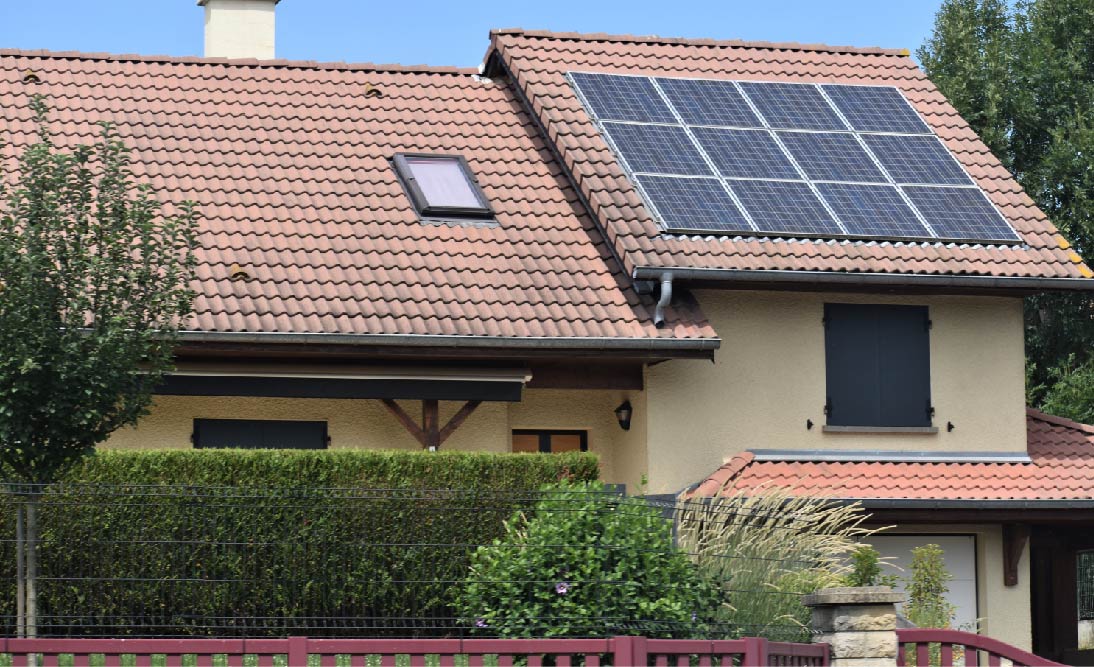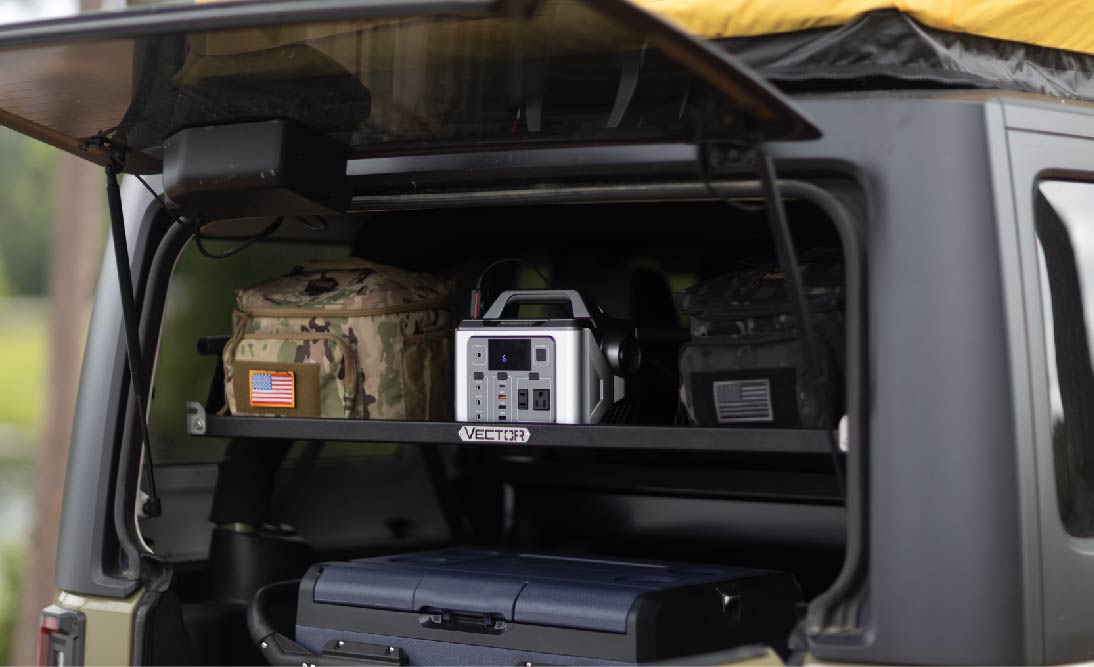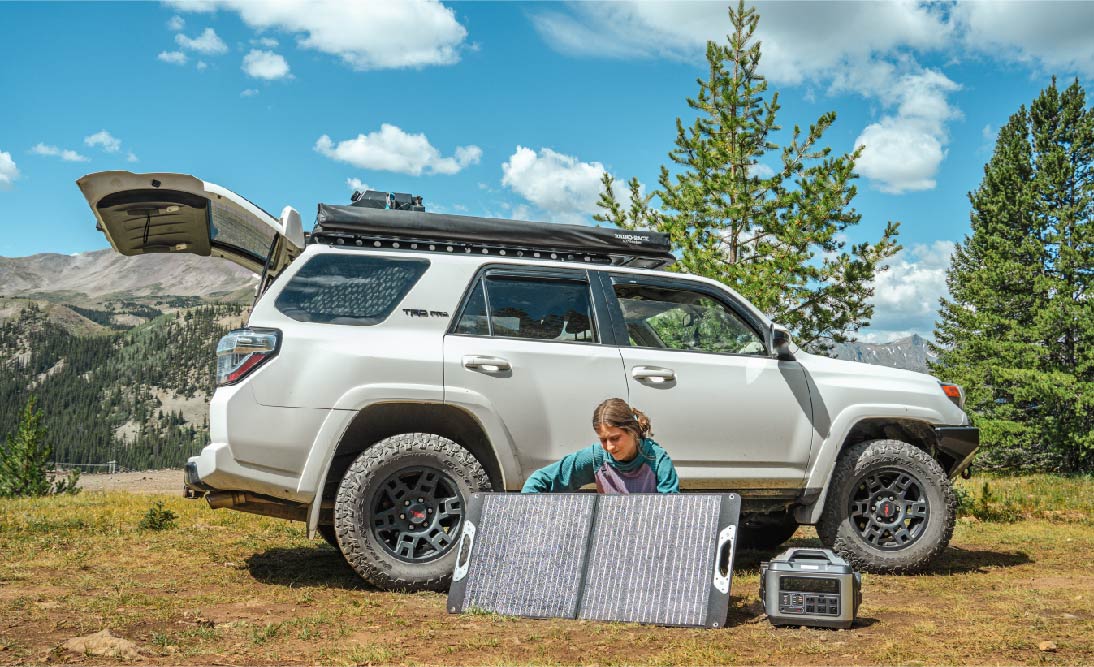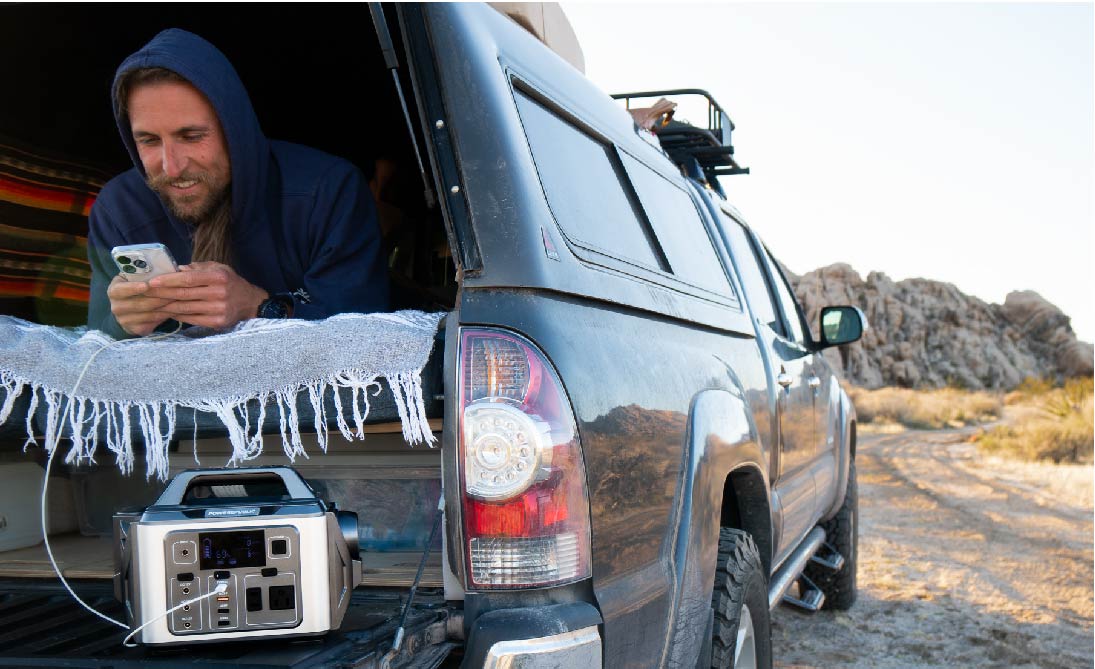Table of Contents:
-
Can Portable Power Stations Count as Batteries for Solar Off-Grid?
-
Best Batteries for Solar Off-Grid: POWEREPUBLIC T2200 and T3000 Models
-
FAQ II: Is it Worth it To Have Batteries for Solar Off-Grid?
The battery system is one of the most critical components of sustainable living and energy independence. For those living off-grid where traditional electricity is not always available, having reliable solar power solutions is essential to keep all your devices and appliances charged and maintain daily life. The heart of any solar system is its batteries, which store energy from the sun or other sources for later use.
In this introduction, we'll explore what batteries for solar off-grid systems are, how they work, the different types available, and their price range, including examples and calculations. We'll also examine whether portable power stations can serve as reliable batteries for solar off-grid systems, offering you more options if you prefer a temporary battery backup solution compared to a permanent solar power system. This knowledge is crucial in selecting the best batteries for solar off-grid setups. We hope you find this guide useful in clarifying which batteries to choose for your solar off-grid needs.
Let's dive into it!
Intro to Batteries for Solar Off-Grid
What are Batteries for Solar Off-Grid?
Batteries for solar off-grid are energy storage devices that store electrical power generated by solar panels. During the day, solar panels convert sunlight into electricity. Instead of this electricity going to waste or solely powering immediate needs, it gets stored in these batteries. This stored energy can then be used when the sun isn't shining, ensuring a continuous power supply for off-grid living.

How Do They Work?
The operation of batteries in a solar off-grid system is straightforward yet ingenious. Solar panels collect sunlight and convert it into direct current (DC) electricity. This electricity flows to the batteries, where a chemical reaction happens inside the battery cells, storing the energy. When power is needed, the stored energy in the batteries is converted back into electricity and supplied to the home or facility.
Price Range
The cost of the best batteries for solar off-grid can vary significantly based on type, capacity, and brand. For example:
-
Lead-Acid Batteries: Ranging from $200 to $500 per unit for a decent capacity.
-
Lithium-Ion Batteries: Generally starting around $1,000 and can go upwards of $5,000 for high-end models.
-
An example calculation: If an off-grid home requires 5 kWh of storage per day, and a lithium-ion battery offers 100 Ah at 48V (4.8 kWh), it would need at least one such battery. This setup could cost around $4,000 to $5,000, depending on the brand and model.
Here, understanding the types and costs of batteries is crucial in setting up an efficient solar off-grid system. The best batteries for solar off-grid will depend on individual energy needs, budgets, and preferences. With advancements in technology, the options and capabilities of these batteries are constantly evolving, offering more reliable and sustainable solutions for off-grid living.
Different Types of Batteries for Solar Off-Grid
When considering the best batteries for solar off-grid systems, it's important to understand the various types available. Let’s explore these options to help you determine the best batteries for your solar off-grid setup.

Lead-Acid Batteries
-
What They Are: Lead-acid batteries are the traditional choice for off-grid solar systems. They are widely used due to their affordability and availability.
-
Price Range: Typically, they range from $200 to $500 per unit, depending on capacity and quality.
-
Example Calculation: For a system needing 5 kWh of storage, you might need multiple lead-acid batteries, which could total around $1,000 to $2,000.
Lithium-Ion Batteries
-
What They Are: Lithium-ion batteries are becoming increasingly popular for solar off-grid systems. They are known for their high efficiency and long lifespan.
-
Price Range: These batteries generally start around $1,000 and can exceed $5,000 for high-capacity models.
-
Example Calculation: If an off-grid home requires 5 kWh of storage daily, a single lithium-ion battery with 100 Ah at 48V (4.8 kWh) may suffice, costing around $4,000 to $5,000.
Saltwater Batteries
-
What They Are: Saltwater batteries use saltwater electrolytes and are an environmentally friendly option. They are newer in the market and are gaining attention for their safety and sustainability.
-
Price Range: The cost of saltwater batteries is similar to or slightly higher than lithium-ion batteries.
Nickel-Iron Batteries
-
What They Are: Nickel-iron batteries are known for their incredibly long lifespan, sometimes lasting decades.
-
Price Range: They can be more expensive than lead-acid and lithium-ion batteries, but their longevity make them worth the price.
Overall, the best batteries for solar off-grid systems depend on individual energy needs, environmental considerations, and budget. Lithium-ion batteries are often considered the best overall choice due to their efficiency, lifespan, and decreasing cost over time. However, for those with a limited budget or specific environmental concerns, lead-acid, saltwater, or nickel-iron batteries might be more suitable. It's essential to calculate your energy needs accurately and consider the costs and benefits of each battery type to make an informed decision.
Strength and Limitations of Batteries for Solar Off-Grid
Before selecting the best batteries for solar off-grid systems, it's crucial to weigh their strengths and limitations. This balance will guide you in choosing a battery that meets your energy needs while fitting into your budget. Here we discuss the strengths and limitations of various batteries, helping you identify the best batteries for your solar off-grid setup.

Lead-Acid Batteries
-
Strengths: Lead-acid batteries are cost-effective and widely available, making them a popular choice for those new to solar off-grid living. They're relatively straightforward to recycle, adding to their environmental appeal.
-
Limitations: Their lower lifespan, around 5-7 years, and lower DoD mean they may require more frequent replacement. They also need regular maintenance, such as water level checks and terminal cleaning.
-
Example: For a cabin requiring 3 kWh per day, several lead-acid batteries totaling $1,500 might suffice but could need replacement in 5 years, doubling the cost over a decade.
Lithium-Ion Batteries
-
Strengths: These batteries are known for their high efficiency, longer lifespan (up to 15 years or more), and higher DoD. They require minimal maintenance and are more compact, making them ideal for space-constrained setups.
-
Limitations: The primary limitation is the initial cost, which is significantly higher than lead-acid batteries.
-
Example: A single lithium-ion battery costing $4,000 may meet the same needs as the above example but last three times longer, offering better long-term value.
Saltwater Batteries
-
Strengths: Saltwater batteries are eco-friendly, non-toxic, and fully recyclable, presenting a sustainable option. They are also safe, with no risk of fire or explosion.
-
Limitations: These batteries are larger and heavier than lithium-ion and have a lower energy density. They are also relatively new in the market, which can mean limited availability and support.
-
Example: For an environmentally-conscious user, the investment in saltwater batteries may be higher initially but aligns with sustainable values.
Nickel-Iron Batteries
-
Strengths: Their exceptionally long lifespan, often several decades, makes them a one-time investment for many users. They have a high tolerance for overcharging and deep discharging.
-
Limitations: They are less efficient, have a higher self-discharge rate, and can be more expensive upfront.
-
Example: In a scenario where long-term reliability is crucial, the high initial cost of nickel-iron batteries might be justified by their longevity and robustness.
So, the best batteries for solar off-grid depend on a balance of cost, efficiency, lifespan, maintenance requirements, and environmental impact. Lithium-ion batteries are often the go-to choice for their overall efficiency and cost-effectiveness. However, for specific needs like budget constraints or eco-friendliness, alternatives like lead-acid, saltwater, or nickel-iron batteries can be the best fit. Accurate energy needs calculations and a thorough understanding of each type's strengths and limitations are key in making an informed decision for your solar off-grid system.
How To Choose the Best Batteries for Solar Off-Grid?
Choosing the best batteries for solar off-grid requires a comprehensive understanding of your energy needs, budget, and the specific characteristics of different battery types. This guide aims to provide you with the essential information to make an informed decision about the best batteries for your solar off-grid setup, ensuring a balance between performance, cost, and sustainability.

Assess Your Energy Needs
-
Before selecting the best batteries for solar off-grid, calculate your daily energy consumption. For instance, if your home consumes 10 kWh per day, you need a battery system capable of storing and delivering this amount of energy efficiently.
-
Example: A setup with multiple lithium-ion batteries, each providing 5 kWh, can be an ideal solution, ensuring enough power even on days with less sunlight.
Consider Battery Type and Efficiency
-
Different battery types offer varying efficiencies and lifespans. Lithium-ion batteries are often considered the best batteries for solar off-grid due to their high efficiency and longer lifespan.
-
Calculation Example: If a lithium-ion battery has 95% efficiency and you need 10 kWh, you would require a battery system of around 10.5 kWh to account for energy losses.
Consider the Depth of Discharge (DoD)
-
DoD is the percentage of the battery that has been discharged relative to the overall capacity. Batteries with a higher DoD have a longer usable life.
-
Example: A lithium-ion battery with 80% DoD is preferable over a lead-acid battery with 50% DoD for the same capacity.
Evaluate Cost and Longevity
-
The initial investment in the best batteries for solar off-grid can vary. While lithium-ion batteries have a higher price, their longer lifespan and lower maintenance needs can make them a better choice.
-
Cost Analysis: Investing $5,000 in a lithium-ion battery might seem steep, but if it lasts over 15 years, the cost per year is significantly lower compared to cheaper batteries that might need replacement every 5-7 years.
Check for Compatibility and Safety
-
Ensure the batteries are compatible with your solar system components and meet safety standards.
-
Example: Lithium-ion batteries often require a specific type of solar inverter and charge controller for optimal performance.
Examine Environmental Impact
-
For those prioritizing sustainability, the environmental impact of batteries is a crucial factor. Saltwater batteries, while slightly less efficient than lithium-ion, offer an eco-friendly option and are gaining popularity as one of the best batteries for solar off-grid in terms of environmental footprint.
-
Sustainability Example: Choosing saltwater batteries, despite a higher initial cost, aligns with eco-friendly goals and provides a sustainable power storage solution.
Space and Weight Considerations
-
The physical size and weight of batteries can impact where they can be installed. Lithium-ion batteries are compact and lightweight, making them suitable for space-constrained setups.
-
Installation Example: In a small off-grid cabin, the compact size of lithium-ion batteries can be a deciding factor in considering them as the best batteries for solar off-grid.
Maintenance and Safety
-
Maintenance requirements vary between battery types. Lead-acid batteries, while affordable, require regular maintenance and monitoring.
-
Safety Example: Lithium-ion batteries are generally safer and require less maintenance, adding to their appeal as the best batteries for solar off-grid, especially for those who prefer a low-maintenance solution.
Selecting the best batteries for solar off-grid involves balancing efficiency, cost, lifespan, environmental impact, space requirements, and safety. Lithium-ion batteries often emerge as the top choice due to their efficiency and long-term value, but other types like saltwater or nickel-iron might be more appropriate depending on specific needs and values. Accurate energy needs calculations and considering the long-term implications of your choice will guide you in selecting the most suitable batteries for your off-grid solar system.
Can Portable Power Stations Count as Batteries for Solar Off-Grid?
Yes, portable power stations can serve as batteries for solar off-grid systems. They provide a flexible and convenient option for those seeking temporary or mobile energy solutions. When evaluating them as the best batteries for solar off-grid, it's important to consider their advantages and disadvantages, as well as their lifespan.

Pros of Using Portable Power Stations for Solar Off-Grid
-
Flexibility and Portability: Portable power stations are easy to move and set up, making them ideal for temporary setups or mobile applications like camping or RV use.
-
Ease of Use: They often come with multiple outlets and are ready to use out of the box, requiring no complex installation.
-
Compatibility with Solar Panels: Many models are designed to be charged via solar panels, making them a viable part of a solar off-grid system.
-
Quiet Operation and Safety: Portable power stations operate silently and are generally safe, with no emissions and minimal maintenance.
Cons of Using Portable Power Stations for Solar Off-Grid
-
Limited Capacity and Scalability: They usually have less storage capacity compared to traditional solar batteries, limiting their ability to power homes or larger devices for extended periods.
-
Higher Cost per Kilowatt-Hour: While convenient, they may not be the most cost-effective solution for long-term or large-scale energy needs.
-
Durability and Lifespan: Portable power stations may not be as durable as stationary batteries, and their lifespan can be shorter under heavy use.
Lifespan of Portable Power Stations
The lifespan of portable power stations varies based on their battery technology (usually lithium-ion) and usage patterns. Generally, they last between 3 to 5 years or about 500 to 1000 charge cycles. For example, if a portable power station is used and recharged daily, it would typically reach the lower end of its lifespan range.
Price Ranges for Portable Power Stations
-
Entry-Level Models (Under 1 kWh): These typically range from $200 to $500 or more. They are suitable for charging small devices like smartphones, cameras, and laptops. Example: A 300Wh portable power station priced around $300.
-
Mid-Range Models (1 kWh to 2 kWh): Prices for these models generally fall between $500 to $1,500 or more. They can power larger devices and are suitable for short camping trips or backup power for essential items. Example: A 1 kWh portable power station may cost about $1,000.
-
High-Capacity Models (Above 2 kWh): These are priced from $1,500 to $3,000 or more. They offer enough capacity to run several devices for a longer period and can be an integral part of a more comprehensive solar off-grid system. Example: A 2 kWh portable power station might be priced around $2,500.
-
Example: Consider a portable power station with a 1 kWh capacity priced at $1,000. If used as a backup for essential devices during non-sunny hours in a solar off-grid setup, it might provide enough power for basic needs like charging phones, laptops, TVs, and small appliances. However, for larger homes or continuous usage, multiple units or a combination with traditional solar batteries might be necessary.
While portable power stations can be considered as one of the best batteries for solar off-grid due to their convenience and ease of use, they may not be the most cost-effective or scalable solution for all scenarios. For those prioritizing flexibility and portability, they are an excellent choice. However, for long-term, large-scale energy needs, traditional solar batteries might be more appropriate. Balancing these factors is key to selecting the best batteries for your solar off-grid needs.
Best Batteries for Solar Off-Grid: POWEREPUBLIC T2200 and T3000 Models
As we know, portable power stations provide a flexible and convenient option for those seeking temporary or mobile energy solutions. However, they are not suitable for long-term and large-scale energy needs in solar off-grid scenarios.

For those who are looking for the best batteries for solar off-grid under temporary conditions, we recommend two models from POWEREPUBLIC: the T2200 and T3000 portable power stations. Both are compatible with solar panels and powerful enough to run almost 90 to 95% of devices and home appliances, making them ideal batteries for solar off-grid with less energy needs and for temporary power outages that last a couple of hours.
To display the functionality and versatility of these two models, check out the table below:
|
Feature/Model |
||
|
Capacity |
2240Wh/100,000mAh |
3200Wh/125,000mAh |
|
Continuous Power |
2200W |
3000W |
|
Starting Power |
4500W |
6000W |
|
Battery Type |
LiFePO4 Batteries(3000+ cycles) |
LiFePO4 Batteries(3000+ cycles) |
|
Number of Output Ports |
15 Output Ports |
15 Output Ports |
|
Input |
AC Adapter, Solar Panel, Car Charger |
AC Adapter, Solar Panel, Car Charger |
|
Solar Input |
230W |
230W |
|
Weight |
64Ibs/30Kg |
88Ibs/40Kg |
|
Dimensions |
18.3*11.8*12.2 inch |
18.3*11.8*14.5 inch |
|
Check out Trustpilot for Brand Rating and Reviews |
||
|
Est. Duration(h) |
Duration(h)=Capacity(Wh) * 0.85 / The power of the item(W) |
|
|
TV (100W) |
18 to 19 hours |
26 to 27 hours |
|
Refrigerator (300W) |
5 to 6 hours |
8 to 9 hours |
|
Microwave Oven (800W) |
1 to 2 hours |
3 to 3.5 hours |
|
Coffee Maker (1000W) |
1 to 2 hours |
2 to 2.5 hours |
|
Toaster (1200W) |
1 to 1.5 hours |
2 hours |
|
Washing Machine (1200W) |
1 to 1.5 hours |
2 hours |
|
Space Heater (1500W) |
1 hour |
1 to 1.5 hours |
|
Electric Chainsaw (2400W) |
/ |
0.5 to 1 hour |
Please Note That:
-
The duration is calculated based on powering ONLY one item at a time with the battery fully charged.
-
Actual wattages of devices and appliances may vary by brand.
-
Make sure to check both the running and starting wattage of your devices and appliances. The power of your items, both running and starting, should NOT be larger than that of the portable power station.
FAQ I: How Long Do Batteries for Solar Off-Grid Last?
Answer: The lifespan of batteries for solar off-grid systems varies depending on the type of battery and how it's used.

So on average:
-
Lead-Acid Batteries: Last about 5-7 years.
-
Lithium-Ion Batteries: Can last up to 15 years or more.
-
Saltwater Batteries: Typically have a similar lifespan to lithium-ion batteries.
-
Nickel-Iron Batteries: Known for their incredibly long lifespan, often several decades.
Example Calculation: If you're using a lithium-ion battery with a lifespan of 15 years in a solar off-grid system, and it costs you $5,000, the annual cost of the battery would be about $333 ($5,000 divided by 15 years).
FAQ II: Is it Worth it To Have Batteries for Solar Off-Grid?
Answer: Absolutely, investing in batteries for solar off-grid systems is often a wise decision, particularly for enhancing energy independence and reliability.

The worthiness of this investment depends on several factors:
-
Location and Grid Reliability: In remote areas or places with unreliable grid power, solar batteries provide essential backup, ensuring continuous power supply.
-
Cost Savings Over Time: Although the initial investment might be substantial, solar batteries can lead to significant savings by reducing or eliminating reliance on the grid.
-
Environmental Benefits: Solar batteries contribute to a smaller carbon footprint, aligning with eco-friendly living principles.
-
Example I: Consider a household in a remote area where the electricity cost is 12 cents per kWh. If the household's daily energy consumption is 10 kWh, the monthly electricity cost would be approximately $36 (10 kWh x $0.12 x 30 days). By investing in a solar battery system, this cost can be significantly reduced or even eliminated.
-
Example II: Suppose the cost of a suitable solar battery system is $5,000, with a lifespan of 15 years. Over these 15 years, the total cost saved from not having to pay for grid electricity would be $6,480 per year ($36 x 12 months), amounting to $97,200 over the battery's lifespan. Even after accounting for the initial investment, the net savings is substantial.
FAQ III: How To DIY an Off-Grid Solar System?
Answer: Creating a DIY off-grid solar system involves several key steps, each requiring careful consideration and planning:
1. Assess Energy Requirements: Calculate your daily and monthly energy usage in kWh. If your home uses 30 kWh per day, your monthly usage would be 900 kWh (30 kWh x 30 days).
2. Selecting Solar Panels: Choose the number and type of solar panels based on your energy needs and available space. For a 900 kWh monthly requirement, assuming 5 peak sun hours per day, you would need about 6 kW of solar panels (900 kWh / (30 days x 5 hours)).
3. Choosing Batteries: Determine the right battery type and capacity. For a 30 kWh daily usage and assuming you want 3 days of autonomy, you would need a battery capacity of at least 90 kWh (30 kWh x 3 days).
4. Inverter and Charge Controller Selection: Choose an inverter that can handle your peak power demand and a charge controller suited for your solar panel output and battery type.
5. Installation Process: Install the solar panels, batteries, inverter, and charge controller. Make sure they are properly connected, following safety guidelines.
6. Safety Tip: Always ensure electrical connections are secure and use proper grounding techniques.
7. Maintenance and Monitoring: Regularly check the system for optimal performance and longevity.
8. Analyzing Your Budget:
-
Solar Panels: Estimate cost based on size and efficiency. For 6 kW, expect a range of $1.50 to $3.00 per watt, totaling $9,000 to $18,000.
-
Batteries: Cost depends on type and capacity. Lithium-ion batteries, for example, might cost around $500 per kWh, amounting to $45,000 for 90 kWh.
-
Inverter and Charge Controller: Approximately $2,000 to $5,000, depending on capacity and features.
-
Installation and Miscellaneous: Include costs for mounting, wiring, and safety equipment, possibly another $1,000 to $5,000.
-
Total Estimated Budget: Summing these costs gives a range of $57,000 to $73,000. This estimate can vary based on specific equipment choices, regional prices, and potential labor costs if professional installation is needed.
-
Long-Term Savings: Calculate potential savings by reducing or eliminating reliance on grid electricity. Consider maintenance costs and possible future upgrades.

DIY installation of an off-grid solar system requires a substantial financial commitment and a deep understanding of electrical systems. It's essential to carefully plan your budget and consider long-term financial implications. For those not experienced in electrical installations, consulting with a professional is highly advisable to ensure safety and system efficiency.
Final Thoughts
In summary, selecting the best batteries for solar off-grid is pivotal for anyone seeking a sustainable and independent energy solution. The best batteries for solar off-grid vary based on individual needs, with options like lead-acid, lithium-ion, saltwater, and nickel-iron batteries each offering unique benefits. Lithium-ion batteries, known for their efficiency and long lifespan, often stand out as the optimal choice. However, for specific scenarios, particularly where environmental considerations or budget constraints are prominent, alternatives like saltwater or nickel-iron batteries may be more suitable.
For those with less energy needs or seeking a temporary solution, the POWEREPUBLIC T2200 and T3000 models emerge as excellent portable power station options, providing flexibility and convenience. These models are particularly adept at handling temporary power outages or complementing a solar off-grid setup. It's essential to carefully evaluate your energy requirements, budget, and long-term goals to make a better decision, ensuring you choose the most appropriate and efficient battery system for your off-grid living.
Find out more about POWEREPUBLIC Portable Power Stations and Solar Generator Kits!













